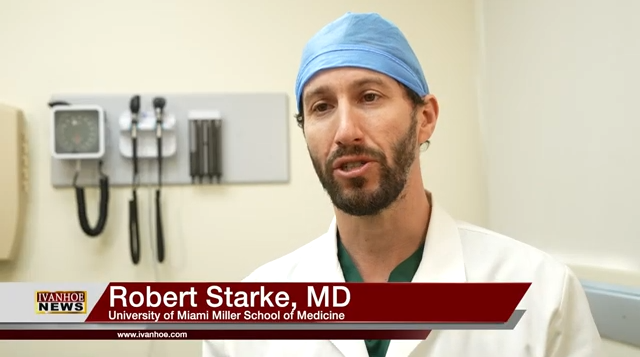Neurosurgeon at University of Miami Miller School of Medicine, Robert Starke, MD talks about treating vascular malformations with awake surgery.
Interview conducted by Ivanhoe Broadcast News in 2023.
What are vascular malformations?
Starke: Vascular malformations in the brain are usually a collection of abnormal blood vessels that can cause bleeding or seizures or other neurological problems in the brain.
So we talked to your patient Fernando Vera last night. What did Fernando have?
Starke: So, he had a cerebral vascular malformation of the brain called the cavernoma, which is a collection of blood vessels that creates a ball. And those collection of blood vessels can cause bleeding in the brain or seizures.
Can you have these and not even know you have it?
Starke: That’s right.
And how often is that, until something bad happens and then you know you have it?
Starke: We really don’t know. It’s different in every person. Sometimes these present in children and sometimes they present in elderly patients that don’t have a problem through their whole life. And probably some people go their whole lives with them without having a problem.
What can happen, like in Fernando’s case, if that didn’t get taken care of, what could have happened to him?
Starke: Well, he had a bleed in the brain and bleeding in the brain can cause any neurological problem including death, paralysis, inability to talk or move, or seizures. And so each time that you have a bleed, you’re more likely to have another bleed. And each time that can cause any sorts of different types of disabilities.
Now, Fernando’s really healthy, really young. Is that unusual to have someone with his health, his age, or can it strike anybody?
Starke: Yeah, unfortunately it can strike anybody. These are often found in young, healthy people, even children. But it can occur all the way up into elderly patients. And sometimes, these patients have medical comorbidities, but sometimes they have no past medical history.
Now, is surgery always the answer?
Starke: So for cerebral vascular malformations of the brain, there’s usually four options. One is observation and following them. Number 2 is microsurgery, where we go in and remove it. Number 3 is fixing it with interventional neuroradiology, where we go through the blood vessel in the arm or the leg. Number 4 is focused radiation. Now for his type of problem, the most common options are either observation or surgery.
What was fascinating for surgery, you keep them awake?
Starke: So most of the time, this type of surgery is done asleep. He had a number of opinions by other doctors who felt that this surgery was not possible because it’s so close to the speech areas. On top of that, we didn’t precisely know where the seizures were coming from. Now if we do the surgery awake, I’m able to stimulate those areas to carefully identify where are the speech centers and where are the seizures coming from. And that way we can go in and remove the cavernoma or the vascular malformation without disturbing the normal parts of the brain.
Someone told me that you might be able to share Fernando’s video with me of him being awake, is that right?
Starke: That’s right. So, I thought up front this would be a really interesting case, so we consented him beforehand and we took video from inside the operating room and he basically tells me his life story while I’m on the other side of the curtain operating.
Can you tell me a little bit about the operation and what you do?
Starke: Yeah. The nice thing about this is with special imaging, we’re able to identify those functionally important areas of the brain. That allows us to really make a tiny incision by using an instrument that we place on the brain that allows us to then see exactly where we are on large screens on the MRI in front of us. So that allows us to make a tiny incision and opening, we remove a piece of the bone, and then we use a huge microscope that’s bigger than all of us put together to make a tiny opening and go in and remove this malformation.
And so as far, as his case, it went perfect, right?
Starke: Yeah, he was already awake. But he was unchanged after the surgery and pretty much went back to his activities of daily living right afterwards.
Is there anyone that you would not do this surgery on?
Starke: So sometimes if people have a low risk of bleeding and the surgery is extremely high risk, then I follow those patients with monthly or yearly imaging over time and we don’t operate on them unless they have a problem.
Great. Any signs, because he seemed to have some signs that he completely ignored and just chalked it up to other things. Is there something that is a sign of these malformations that people need to be aware of?
Starke: Yeah, I mean, it’s usually significant neurological changes and that could be weakness or numbness, problem seeing, funny smells. But unfortunately, sometimes it’s just significant headaches and it goes a while before these things are found.
Do you feel like a lot of times, people will either just chalk it up to something else or it’s misdiagnosed and it’s what we’ve been mostly going to be misdiagnosed as?
Starke: Well, when we first get imaging in the brain, sometimes this could be confused for a brain tumor or other benign alterations. The problem is, is that these cerebrovascular malformations are more likely to bleed in the brain and that can cause major neurological problems.
Fernando is a great guy because he was so sweet yesterday and he wanted to play with his two little boys. Have you been able to meet his little boys? I mean, that’s something where his options are maybe, never being normal and then living a normal life, to being right back at it with these two little guys.
Starke: Yeah, I have a 10-year-old, so I was just trying to put myself in the shoes of the patient and think about what I would want to do if I was in his situation. And that usually makes the decision-making fairly easy for me.
Okay, perfect. Anything you’re missing?
Starke: I think, maybe two other important points are I might be the only doctor in Florida that does all three treatment options for vascular malformations of the brain, which are surgical resection, treating it through interventional neuroradiology by going through the arm of the leg, or focused radiation. Additionally, we are a overall center of excellence for the angioma alliance. We’re one of only a few in the entire United States and the only overall center in Florida that specializes in care for people with these types of vascular malformations. And the angioma alliance brings together doctors here at University of Miami in neurosurgery/neurology, epilepsy genetics, radiology and research to collaborate together for these types of rare vascular malformations. And so we do have patients that come from often very far away to get further opinions here or their treatment here because we’re one of the few centers of excellence.
That’s excellent. Great. Thank you. Could you also tell me a little bit about the one that you do through the catheter, the radiation through the catheter?
Starke: Yeah. For other types of vascular malformations, we can access the brain in a minimally invasive fashion by going through a tiny catheter, which looks like a microscopic straw that can be placed inside the blood vessel through an IV that we place either in the wrist or the leg. And then we can guide that catheter all the way up into the brain to inject glue or other materials to block vascular malformations. So the nice thing about that is it doesn’t require any incisions, it’s minimally invasive. Oftentimes, patients are treated and they can go home the next morning.
So, why wouldn’t you choose that for Fernando?
Starke: So in his case, his type of vascular malformation doesn’t have direct arteries that supply it so there’s not a good avenue to get there directly to treat it with interventional neuroradiology.
So, are you just basically starving or cutting off the malformation from blood supply and it just dies and goes away?
Starke: That’s exactly right. So instead of there being high-pressure blood flow that’s going into the malformation, the glue prevents the blood from going in and then there’s really no risk of bleeding if it’s successfully treated. And then the last option, I guess real briefly, the last treatment option is focused radiation. So in that case, it’s minimally invasive because you just go into a machine, we shoot radiation from hundreds of different directions to a single small point and that basically burns or kills the lesion. So that’s another way of treating these vascular malformations in the brain in a minimally invasive fashion.
END OF INTERVIEW
This information is intended for additional research purposes only. It is not to be used as a prescription or advice from Ivanhoe Broadcast News, Inc. or any medical professional interviewed. Ivanhoe Broadcast News, Inc. assumes no responsibility for the depth or accuracy of physician statements. Procedures or medicines apply to different people and medical factors; always consult your physician on medical matters.
If you would like more information, please contact:
Kai Hill Joanna Palmer
khill@med.miami.edu Joanna.palmer@med.miami.edu
Sign up for a free weekly e-mail on Medical Breakthroughs called First to Know by clicking here




